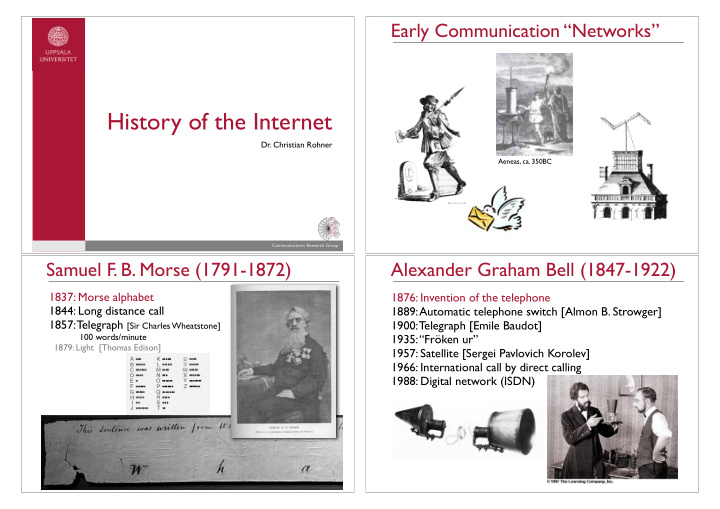



Early Communication “Networks” History of the Internet Dr. Christian Rohner Aeneas, ca. 350BC Communications Research Group Samuel F. B. Morse (1791-1872) Alexander Graham Bell (1847-1922) 1837: Morse alphabet 1876: Invention of the telephone 1844: Long distance call 1889: Automatic telephone switch [Almon B. Strowger] 1857: Telegraph [Sir Charles Wheatstone] 1900: Telegraph [Emile Baudot] � 100 words/minute 1935: “Fröken ur” 1879: Light [Thomas Edison] 1957: Satellite [Sergei Pavlovich Korolev] 1966: International call by direct calling 1988: Digital network (ISDN)
Telephone Network Circuit Switching circuit |ˈsərkət| noun 1 a roughly circular line, route, or movement that starts and finishes at the same place : I ran a circuit of the village. • a complete and closed path around which a circulating electric current can flow. • a system of electrical conductors and components forming such a path. Telephone Switch in Paris, 1885 Source: Ericsson AB Advances in Technology Packet Switching • 1947: Transistor [Bardeen and Brattain] Ericsson Telegraph DEC PDP-11 1885 1970
From Circuit to Packet Switched ARPAnet The ARPAnet • 1960: Telephone is the dominant communication network (modem) • 1961: packet switching [Kleinrock] 1972 • 1967: Plan for the ARPAnet as a packet switched net • 1969: First installation at UCLA, Stanford, UCSB, Utah • 1972: first public demonstration (15 nodes) � [Kahn] - NCP (Network Control Protocol), first host-to-host protocol - first e-mail program 1969 1977 Interconnection Connecting to the ARPAnet: Birth of TCP/IP • 1970: ALOHAnet radio network in Hawaii • 1973: Ethernet [Metcalfe] • 1974: Architecture for interconnecting networks [Cerf, Kahn] - minimalism, autonomy - no internal changes required to interconnect networks - best effort service model - stateless routers - decentralised control • late 1970’s: proprietary architectures
Proliferation of Networks Internet Explosion More hosts and more protocols From the University to the People • 1979: 200 hosts connected to the ARPAnet • Early 1990’s: Web - hypertext [Bush 1945, Nelson 1960] • 1990: 100’000 hosts (mainly at universities) - HTML, HTTP [Berners-Lee at CERN] • 1983: NCP > TCP/IP transition (in one day!) - 1994: Mosaic, later Netscape • 1988: TCP congestion control [Jacobson], DNS - late 1990’s: commercialisation of the Web • National networks • Late 1990’s - e.g., Minitel in France: data networking into everyone’s home - more killer applications: instant messaging, peer-to-peer file • X.25, virtual cirquits sharing • 20’000 services: public directories, home banking, research database, etc - network security • 20% of population - >250 million hosts, >0.6 billion users IP addresses 1999
January 2000 October 2000 April 2005 April 2005 http://www.caida.org/analysis/topology/
The Lifecycle of Technology Ubiquitous Computing • Sequence of Innovations - what is hot today, is cold tomorrow - only few technologies have a long lifetime - often, it is not the performance that decides for the success Usage Performance Formfactor etc. Time
Recommend
More recommend